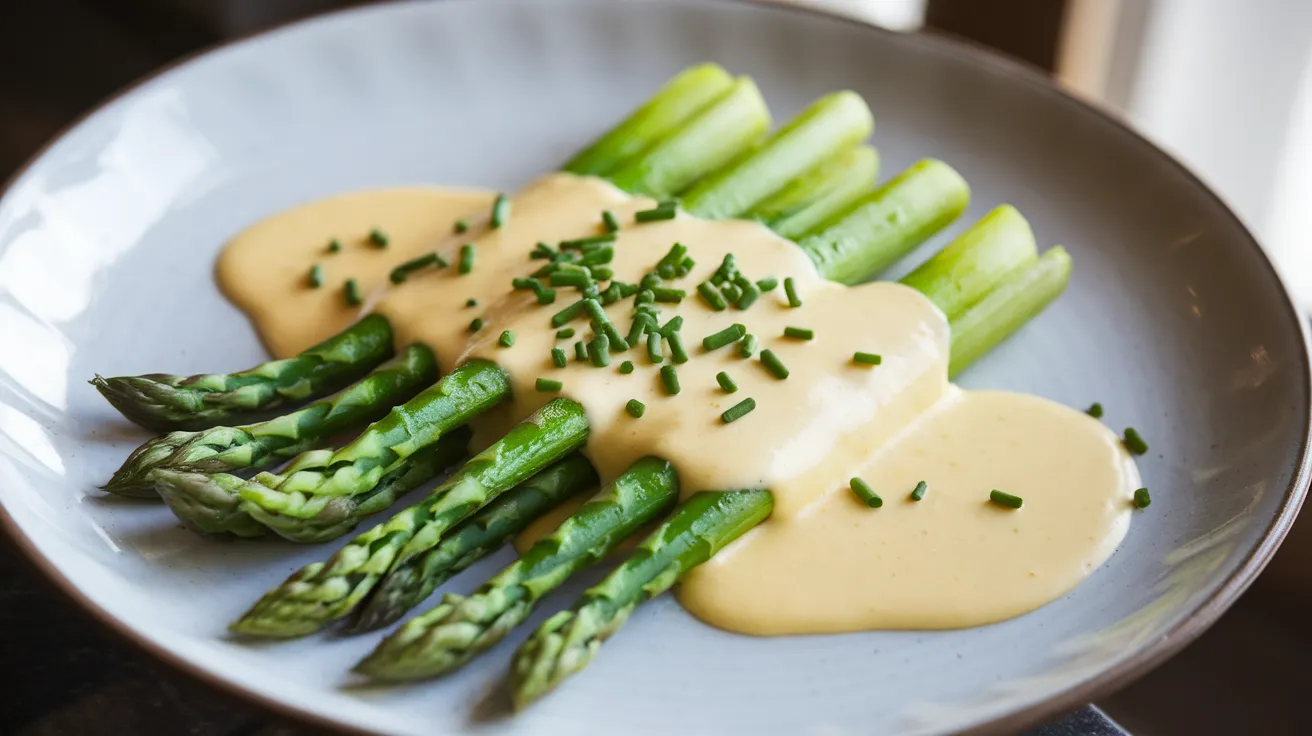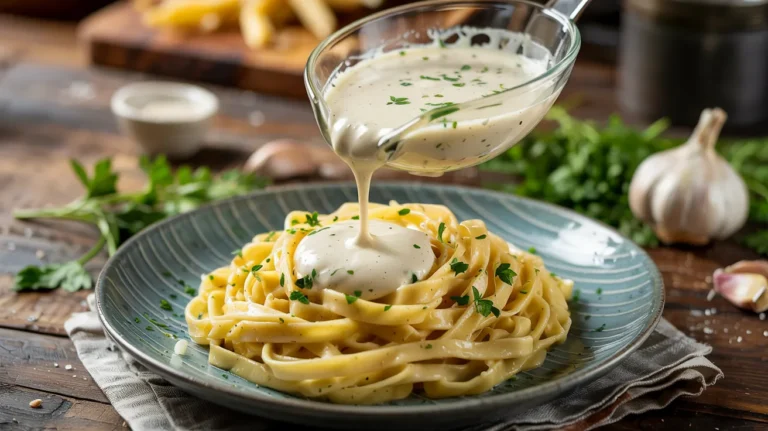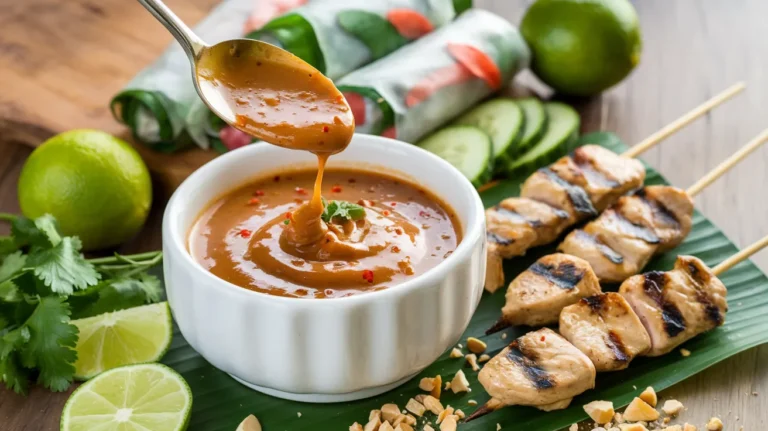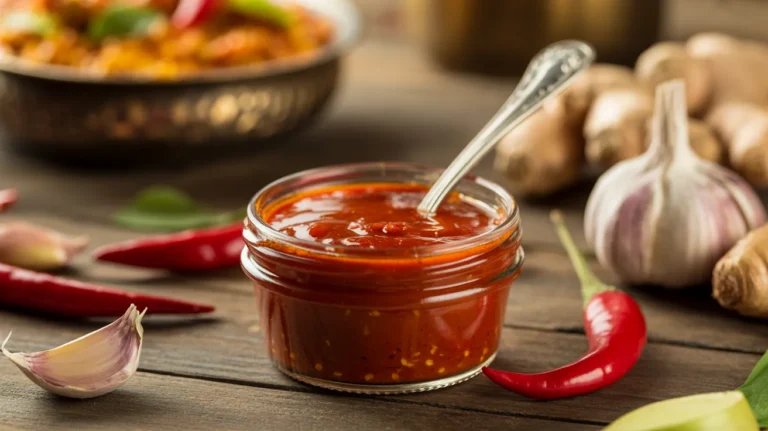This foolproof sauce for asparagus turns ordinary vegetables into an extraordinary side dish that rivals any fine dining restaurant. Our step-by-step guide makes creating the perfect sauce for asparagus simple enough for complete beginners, with rich, buttery flavors that complement tender asparagus spears beautifully.
Recipe Info
SERVES: 4 | PREP: 20 MIN | COOK: 25 MIN | TOTAL: 45 MIN
Ingredients
For the Asparagus
- 2 lbs fresh asparagus spears (about 24-30 spears)
- 1 tablespoon salt for blanching water
- 6 cups ice cubes for shocking
- 8 cups cold water for ice bath
For the Sauce
| Ingredient | Amount | Notes |
|---|---|---|
| Unsalted butter | 6 tablespoons | Room temperature, cubed |
| Large egg yolks | 3 | Separated from whites |
| Fresh lemon juice | 2 tablespoons | About 1/2 large lemon |
| White wine vinegar | 1 tablespoon | Or white vinegar |
| Fine sea salt | 1/2 teaspoon | Plus more to taste |
| White pepper | 1/4 teaspoon | Freshly ground preferred |
| Fresh chives | 2 tablespoons | Finely chopped |
Detailed Step-by-Step Instructions for Beginners
Phase 1: Asparagus Preparation (10 minutes)
1. Select and inspect your asparagus
- Look for bright green spears with tight, closed tips
- Avoid asparagus with slimy or dried-out ends
- Thick spears (pencil-width or larger) work best for this sauce for asparagus recipe
2. Properly trim the asparagus ends
- Hold each spear at both ends
- Bend gently until it snaps naturally – this removes the tough, fibrous part
- The spear will break exactly where the tender part begins
- Discard the tough ends or save them for vegetable stock
3. Rinse and sort the spears
- Rinse asparagus under cold running water
- Pat completely dry with paper towels
- Sort spears by thickness – thick and thin spears cook at different rates
- Keep similar sizes together for even cooking
4. Set up your ice bath station
- Fill a large bowl with 6 cups ice cubes
- Add 8 cups very cold water
- Place the bowl near your stovetop for quick access
- Have a slotted spoon or tongs ready for transferring asparagus
5. Prepare your blanching water
- Fill a large pot (at least 4 quarts) with water
- Add 1 tablespoon salt – this seasons the asparagus and helps retain color
- Bring to a vigorous, rolling boil over high heat
- The water should be bubbling actively before adding asparagus
Phase 2: Creating the Perfect Sauce Base (12 minutes)
6. Set up your double boiler system
- Fill a medium saucepan with 2 inches of water
- Bring to a gentle simmer over medium-low heat
- Place a heatproof glass or stainless steel bowl on top
- The bottom of the bowl should NOT touch the water
- Why this matters: Direct heat will scramble the eggs instantly
7. Separate your eggs with care
- Crack each egg into a small bowl first to check for broken yolks
- Separate whites from yolks, keeping only the yolks
- Pro tip: Save egg whites in the refrigerator for meringues or omelets
- Room temperature eggs separate more easily than cold ones
8. Whisk the acid mixture
- In your double boiler bowl, combine egg yolks, lemon juice, and vinegar
- Whisk vigorously for 30 seconds until well combined
- The mixture should be pale yellow and slightly frothy
- Safety note: Keep whisking constantly from this point forward
9. Cook the sauce base slowly
- Continue whisking the mixture over the simmering water
- Cook for 3-4 minutes, whisking non-stop
- The mixture will gradually thicken and become creamy
- Temperature check: It should reach 160°F on an instant-read thermometer
- Visual cue: The mixture should coat the back of a spoon and leave a clear line when you draw your finger across it
10. Test for proper consistency
- Lift the whisk – the mixture should fall in a thick ribbon
- If it’s too thin, continue cooking for 30 seconds more
- If it starts to look lumpy, remove from heat immediately
- Troubleshooting: Lumps mean the eggs are starting to scramble
Phase 3: Building the Perfect Butter Emulsion (8 minutes)
11. Prepare your butter properly
- Remove the sauce bowl from heat but keep the water simmering
- Cut 6 tablespoons butter into small, uniform cubes (about 1/2 inch each)
- Temperature tip: Butter should be cool but not ice-cold
- Have all cubes ready before starting – this process moves quickly
12. Create the emulsion slowly
- Add one butter cube to the warm sauce base
- Whisk vigorously until completely melted and incorporated
- Wait until each piece is fully absorbed before adding the next
- The sauce should become glossier and thicker with each addition
- Patience is key: Rushing this step will cause the sauce to break
13. Monitor sauce consistency
- After 3 butter cubes, the sauce should start looking creamy
- Continue adding remaining butter one piece at a time
- The finished sauce should be smooth, thick, and luxurious
- Consistency check: It should coat asparagus spears without running off
14. Season your sauce for asparagus
- Add 1/2 teaspoon salt and 1/4 teaspoon white pepper
- Whisk gently to incorporate seasonings
- Taste and adjust – the sauce should be rich but balanced
- Flavor note: The lemon should be present but not overpowering
Phase 4: Cooking Perfect Asparagus (5 minutes)
15. Test your blanching water
- Ensure water is at a rolling boil before proceeding
- Add a test piece of asparagus – it should bubble vigorously around it
- If not boiling hard enough, wait until it returns to a full boil
16. Blanch asparagus by thickness
- Add thicker spears first (they need more cooking time)
- Cook thick spears for 2 minutes, then add thinner spears
- Cook all together for an additional 1-2 minutes
- Doneness test: Spears should be bright green and tender-crisp
- A fork should pierce the stem easily but with slight resistance
17. Shock the asparagus immediately
- Using tongs or a slotted spoon, quickly transfer asparagus to ice bath
- Speed matters: The faster you transfer, the better the color retention
- Let asparagus sit in ice water for 1-2 minutes to stop cooking completely
- This process is called “shocking” and preserves the vibrant green color
18. Drain asparagus thoroughly
- Remove asparagus from ice bath using tongs
- Lay spears on a clean kitchen towel or paper towels
- Pat completely dry – excess water will thin your sauce
- Optional: For warm service, briefly dip asparagus back in hot water for 10 seconds
Phase 5: Final Assembly and Presentation (5 minutes)
19. Warm your serving plates
- Place serving plates in a 200°F oven for 2 minutes, or
- Rinse plates with hot water and dry quickly
- Warm plates help maintain the sauce temperature
20. Arrange asparagus artfully
- Place 6-8 asparagus spears on each warm plate
- Align spears in the same direction for professional presentation
- Leave space between spears for the sauce to pool attractively
21. Apply sauce for asparagus properly
- Using a large spoon, drizzle sauce generously over each serving
- Technique: Start at the tips and work toward the stems
- The sauce should coat each spear while pooling slightly on the plate
- Amount guide: About 2-3 tablespoons of sauce per serving
22. Add final garnish and serve
- Sprinkle freshly chopped chives over the sauced asparagus
- Timing is critical: Serve immediately while sauce is warm and glossy
- The contrast of green chives against the pale sauce creates visual appeal
Professional Chef’s Notes
• Temperature mastery – This sauce for asparagus requires gentle heat throughout. If your sauce breaks, immediately whisk in 1 tablespoon of cold butter to save it.
• Timing strategy – Prepare all ingredients before starting. Once you begin the sauce, you cannot stop to prep other components.
• Quality ingredients matter – Fresh lemon juice and real butter make an enormous difference in the final flavor of your sauce for asparagus.
• Make-ahead option – Complete the sauce through step 14, then rewarm gently in the double boiler just before serving your perfectly prepared asparagus.
Nutrition Information (Per Serving)
- Calories: 195
- Protein: 7g
- Carbohydrates: 9g
- Fat: 16g
- Fiber: 4g
- Sodium: 340mg
- Vitamin K: 85% DV
- Folate: 65% DV
Creative Variations of This Sauce for Asparagus
Mediterranean Herb Sauce
Add 1 tablespoon fresh tarragon and 1 teaspoon minced garlic to create a sophisticated variation. This technique also works beautifully with our cheese sauce for broccoli recipe.
Citrus-Caper Sauce
Incorporate 1 tablespoon capers and 1 teaspoon lemon zest for a bright, briny twist that complements the natural earthiness of asparagus.
Parmesan Cream Sauce
Whisk in 1/3 cup freshly grated Parmigiano-Reggiano at the end for a nutty, umami-rich sauce that pairs perfectly with this technique from our sauce for broccoli collection.
Mustard Hollandaise
Add 1 teaspoon Dijon mustard to the egg yolk mixture for a tangy sauce that cuts through the richness while enhancing the asparagus flavors.
Storage & Reheating Your Sauce for Asparagus
Refrigeration: Store leftover sauce in an airtight container for up to 2 days maximum. The quality deteriorates quickly due to the egg base.
Proper reheating method: Use the double boiler method, whisking constantly over gentle heat. Add warm water one teaspoon at a time if the sauce appears too thick.
Freezing warning: Never freeze this sauce for asparagus – the emulsion will break completely and cannot be restored.
Best practice: Cook asparagus fresh each time, but the sauce can be held warm in the double boiler for up to 30 minutes before serving.
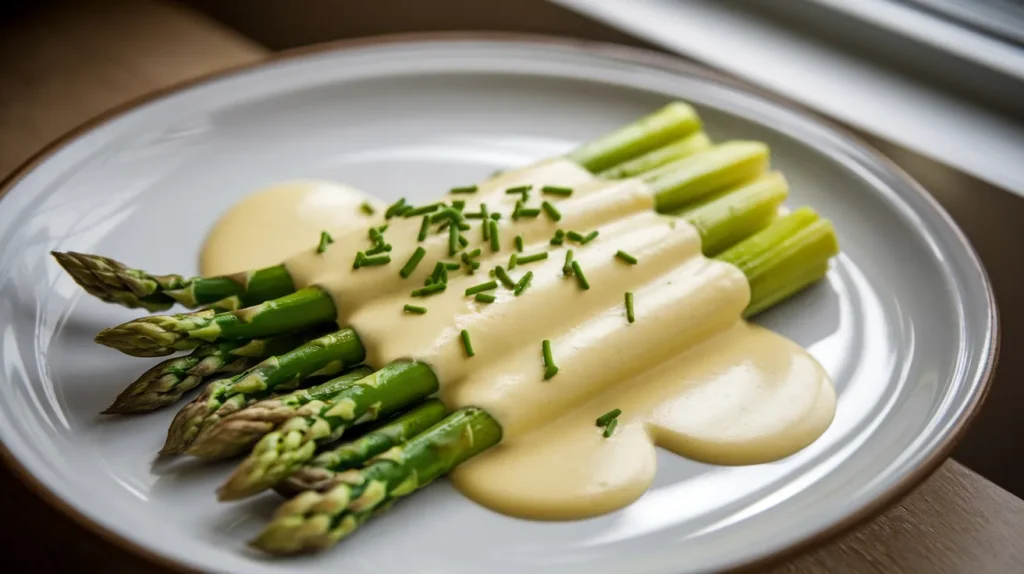
Troubleshooting Your Sauce for Asparagus
Problem: Sauce becomes too thick or paste-like
Detailed solution: Remove from heat immediately. Whisk in warm (not hot) water or additional lemon juice, adding just 1 teaspoon at a time. Continue whisking until the proper consistency returns. This usually happens when the sauce gets too hot.
Problem: Sauce breaks or looks curdled
Detailed solution: Don’t panic! Remove the pan from heat instantly. In a clean bowl, whisk 1 tablespoon of cold butter with 1 teaspoon of the broken sauce. Gradually whisk in the remaining broken sauce, one spoonful at a time. The emulsion should restore.
Problem: Asparagus is mushy or overcooked
Detailed solution: Prevention is key – test doneness every 30 seconds during blanching. For future batches, reduce cooking time by 1 minute. Overcooked asparagus cannot be fixed, but it still tastes good with the sauce.
Problem: Sauce tastes too lemony or acidic
Detailed solution: Balance the acidity by whisking in an extra tablespoon of butter and a pinch of salt. The richness will mellow the sharp flavors naturally.
Problem: Egg yolks scrambled during cooking
Detailed solution: This means the heat was too high. Strain the mixture through a fine-mesh sieve to remove lumps, then start over with fresh yolks. Always keep the water at a gentle simmer, not a rolling boil.
Essential Equipment for Perfect Sauce for Asparagus
- Double boiler setup (medium saucepan + heatproof bowl)
- Large pot for blanching (minimum 4-quart capacity)
- Wire whisk (medium size works best)
- Instant-read thermometer (for monitoring sauce temperature)
- Tongs or slotted spoon (for handling hot asparagus)
- Large mixing bowl (for ice bath)
- Fine-mesh strainer (optional, for emergencies)
- Sharp knife (for chopping chives)
Complete Shopping List
Produce Section
- Fresh asparagus spears (2 pounds)
- Large lemons (need 2 tablespoons juice)
- Fresh chives (1 small bunch)
Dairy Section
- Unsalted butter (1 stick minimum)
- Large eggs (need 3 yolks, buy 6 eggs total)
Pantry Essentials
- White wine vinegar (small bottle)
- Fine sea salt
- White peppercorns (for grinding fresh)
Freezer Section
- Ice cubes (for shocking asparagus)
Five Success Secrets for Perfect Sauce for Asparagus
- Master your heat control – The difference between success and scrambled eggs is gentle, consistent heat. Keep that water at a bare simmer throughout the entire process.
- Prep everything first – This sauce for asparagus waits for no one. Have all ingredients measured, tools ready, and asparagus trimmed before you start cooking.
- Trust the process with butter – Adding butter slowly feels tedious, but this patience creates the silky, restaurant-quality texture that makes this sauce special.
- Timing is everything – Serve this sauce for asparagus immediately after completion. The longer it sits, the more likely it is to break or lose its glossy appearance.
- Practice makes perfect – Don’t worry if your first attempt isn’t flawless. This classic technique improves dramatically with repetition, and even imperfect sauce tastes amazing on fresh asparagus.
